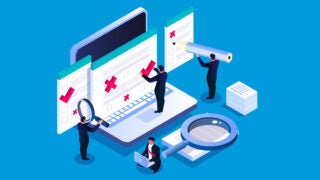Contact: Ron Mackovich, USC Media Relations, rmackovi@usc.edu, (213) 740-2215 or uscnews@usc.edu
A gap in the supply chain

“The COVID-19 pandemic showed how integrated the world has become and how global supply chains helped stage the continent over the last 30 years. However, the disruption caused tremendous impact on the lives of many people across the world. Health care workers on the front lines were impacted most due to the scarcity and disruption of the health care supply chain, specifically in relation to PPE. Fortunately, there are many efforts to bridge the gap, including those by industry experts and academic researchers. I am hopeful that the lessons learned from this once-in-a-century pandemic will help us deal with future disruptions.
“The pandemic caused major disruption and wiped out the global economy. The post-COVID-19 economy and recovery both are yet to be determined in terms of shape and speed. That being said, companies, communities and government will be held responsible for their actions to help ensure that future supply chain network designs are in place to mitigate issues and keep their respective citizens out of harm’s way.”
Nick Vyas is the executive director of the Center for Global Supply Chain Management and an assistant professor of clinical data sciences and operations at the USC Marshall School of Business.
Contact: nikhilvy@marshall.usc.edu
Straining relationships between employers and workers
 “During the COVID-19 pandemic, an array of legal issues awaits employers, assuming they can lawfully operate. Safety is critical, with potential issues ranging from Cal/OSHA citations and worker’s compensation liabilities to wrongful death lawsuits. Flexibility with working time is critical as the workforce requires leaves of absence for health and school disruptions. New schedules and requirements like temperature screenings can impact pay practices. Working relationships may strain with telework or a fear of exposure. Travel may prompt exposure risks and quarantines.
“During the COVID-19 pandemic, an array of legal issues awaits employers, assuming they can lawfully operate. Safety is critical, with potential issues ranging from Cal/OSHA citations and worker’s compensation liabilities to wrongful death lawsuits. Flexibility with working time is critical as the workforce requires leaves of absence for health and school disruptions. New schedules and requirements like temperature screenings can impact pay practices. Working relationships may strain with telework or a fear of exposure. Travel may prompt exposure risks and quarantines.
“Employers should try to stay current with legal standards for day-to-day operations, consistent to avoid potential discrimination and retaliation, and communicative with everyone in the workforce. Employers who are good listeners and nimble in the face of constant change are most likely to succeed in these times. Surmounting these challenges can make businesses and working relationships stronger.”
Thomas Lenz is a lecturer at the USC Gould School of Law.
Contact: lenzt@usc.edu
Bankruptcy threat for lower income workers

“There is a very serious risk of an unprecedented number of personal bankruptcies due to the pandemic. Before the pandemic, it was estimated that 40% of Americans would struggle to meet an unexpected bill of $400. The widespread unemployment caused by the pandemic has fallen disproportionately on low-income workers. The $600-per-week extra unemployment benefits ensured that many of those who lost their jobs could remain current on their obligations. With the end of these benefits, many of the 28 million currently unemployed Americans will have no choice but to file for bankruptcy. The bankruptcy court system probably does not have sufficient resources to process and resolve the coming wave of cases. If Congress neither restores the supplemental unemployment benefits nor acts to increase the capacity of the bankruptcy system, courts will be inundated.”
Robert K. Rasmussen is the J. Thomas McCarthy Trustee Chair in Law and Political Science at the USC Gould School of Law and an expert in bankruptcy and corporate reorganization.
Contact: rkrasmus@usc.edu
Critical decisions for retail, movie theaters and college sports

“Crises accelerate decision-making. COVID-19 is no different. Compelled to identify innovative sources of revenue, organizations are making tactical decisions quickly, not fully grasping their long-term consequences.
“Consider these questions: Will an attempt by the NCAA and college conferences to impose a bubble or a series of bubbles around college basketball herald the end of amateur athletics as we know it? Will Amazon, often labeled the e-commerce slayer of the mall, ironically become its savior as the primary anchor tenant and a brick-and-mortar pillar? Will studios releasing their films only on streaming platforms or video-on-demand during the pandemic effectively finish off the movie theater?”
Kristen Jaconi is an associate professor of practice in accounting with the Leventhal School of Accounting at the USC Marshall School of Business and an expert in risk management.
Contact: kjaconi@usc.edu
The daily fight for survival of a small business during the COVID-19 pandemic

“While small businesses are all different, most share common challenges that typically include limited resources and financing. These challenges have increased exponentially during the COVID-19 pandemic. Most businesses these days are struggling to generate enough income to survive, but small businesses have a harder time weathering the storm because they often have limited financial resources. They also don’t have a team of lawyers that can help them navigate the sea of COVID rules and regulations that change frequently and impact operations at every level. Many business owners are working five times as hard for 15% of the money they made last year. Some challenges can be met by adaptation, such as gyms that now operate in parking lots; some require just waiting out the storm. But most small businesses seem to lack the guidance and support to navigate the sudden economic, regulatory and health challenges that have changed (maybe forever) the rules of the game.”
Michael Chasalow is director of the USC Small Business Clinic at the USC Gould School of Law.
Contact: mchasalow@law.usc.edu
Reality of working from home hits hard
 “For many workers, the fantasy of leisurely working from home has been much more stressful and isolating than they expected. This is partially because the shift to work at home happened so quickly for many employees, without time to get comfortable with technology platforms or to set up routines or home spaces to facilitate a smooth transition.
“For many workers, the fantasy of leisurely working from home has been much more stressful and isolating than they expected. This is partially because the shift to work at home happened so quickly for many employees, without time to get comfortable with technology platforms or to set up routines or home spaces to facilitate a smooth transition.
“More importantly, the pandemic has deprived families of outlets and support. Without school and child care, parents lack the bandwidth to focus on work. Without social gatherings, sports and other leisure activities to blow off steam, single workers can quickly feel lonely, deprived of the casual social contact that’s built into many workplaces. Working from home can be a great solution that affords needed flexibility to many employees, especially parents. But like work done from anywhere, it requires dedicated space and time and the ability to concentrate. Parenting and running the household are both demanding jobs in their own right, and they can’t be layered over the workday in the absence of child care and community.”
Darby Saxbe is an associate professor of psychology at the USC Dornsife College of Letters, Arts and Sciences and director of the USC Dornsife Center for the Changing Family. She’s an expert on stress contagion within families, parenting, division of household labor and the transition to parenthood.
Contact: dsaxbe@usc.edu


 “During the COVID-19 pandemic, an array of legal issues awaits employers, assuming they can lawfully operate. Safety is critical, with potential issues ranging from Cal/OSHA citations and worker’s compensation liabilities to wrongful death lawsuits. Flexibility with working time is critical as the workforce requires leaves of absence for health and school disruptions. New schedules and requirements like temperature screenings can impact pay practices. Working relationships may strain with telework or a fear of exposure. Travel may prompt exposure risks and quarantines.
“During the COVID-19 pandemic, an array of legal issues awaits employers, assuming they can lawfully operate. Safety is critical, with potential issues ranging from Cal/OSHA citations and worker’s compensation liabilities to wrongful death lawsuits. Flexibility with working time is critical as the workforce requires leaves of absence for health and school disruptions. New schedules and requirements like temperature screenings can impact pay practices. Working relationships may strain with telework or a fear of exposure. Travel may prompt exposure risks and quarantines.


 “For many workers, the fantasy of leisurely working from home has been much more stressful and isolating than they expected. This is partially because the shift to work at home happened so quickly for many employees, without time to get comfortable with technology platforms or to set up routines or home spaces to facilitate a smooth transition.
“For many workers, the fantasy of leisurely working from home has been much more stressful and isolating than they expected. This is partially because the shift to work at home happened so quickly for many employees, without time to get comfortable with technology platforms or to set up routines or home spaces to facilitate a smooth transition.

